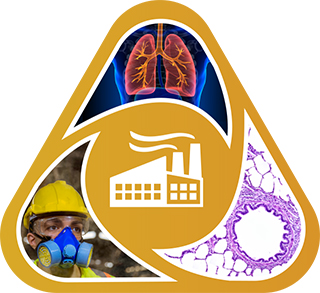
Much of the work carried out by DTT is in support of the National Toxicology Program (NTP), an interagency partnership of the Food and Drug Administration, National Institute for Occupational Safety and Health, and NIEHS.

Public Health Significance
Fatalities from respiratory diseases and cancers caused by inhalation exposures account for approximately 70% of all occupational disease deaths, according to the National Institute for Occupational Safety and Health (NIOSH). These outcomes can be linked to acute or chronic (high- or low-dose) inhalation exposures in a variety of workplace settings. Such effects range from mild, reversible conditions to progressive, chronic, irreversible, and even fatal disorders. Inhalation exposures to toxic compounds tend to occur more frequently in occupational settings, although the general population can also be exposed to similar hazards through inhalation in the environment or consumer use.
Some respiratory diseases caused by inhalation exposures include the following:
- Asthma and fibrosis
- Lung Cancers
- Mesothelioma
- Silicosis and asbestosis
Research Objectives
The Occupational and Inhalation Exposures (OIE) research has the following objectives:
- Assess the human health hazard potential of current and emerging airborne substances of concern to the general population and in the workplace using a tailored combination of traditional and alternative experimental approaches.
- Predict adverse human health effects to the airways and lungs and generate data to support human health risk assessments through evaluation and use of human-relevant microphysiological systems, such as air-liquid interface cell cultures and lung-on-chip systems.
- Enhance the human translational relevance of in vivo and in vitro experimental models for evaluating airborne exposures through application of novel tools and refinement of traditional approaches (e.g., human exposure studies, literature-based assessments, physiological monitoring of animals for in vivo studies, specialized histopathology techniques, and use of humanized rodent models).
This research will actively engage stakeholders and subject matter experts to advance the goal of developing and applying innovative tools and strategies for addressing occupational and inhalation toxicology.
Background
Experimental studies that evaluate the toxicity and carcinogenicity of inhaled substances are challenging to design and conduct due to the complex methods and systems required to characterize, deliver, and monitor exposures in the laboratory testing environment. Nonetheless, robust hazard characterization is critical to creating safe living and working environments and reducing the disease burden associated with inhalation exposures.
Over many years, the NIEHS Division of Translational Toxicology (DTT) has worked to develop scientific and engineering capabilities to design complex inhalation exposure generation and monitoring systems for vapors, gases, liquid aerosols, particles, and fibers. DTT has established robust and unique capabilities to conduct state-of-the-art hazard assessments for inhalation and workplace exposures, enabled by internal resources and external partnerships with federal agencies and contract research laboratories. DTT has also leveraged expertise to address the evaluation of exposure to physical agents.
Data collected from animal studies and human assessments provide a more comprehensive evaluation of human health risks from occupational and inhalation exposures. Insights from such research allow DTT to address the health hazards of recognized and emerging substances of concern, whether affecting the general public or specific workplace settings.
Select Studies
| Study | Description | Findings/Supporting Files |
|---|---|---|
| Naturally Occurring Asbestos and Related Mineral Fibers | This project involves method development for fiber studies, characterization of the inhalational toxicity of asbestos exposure in rodents following short-term or chronic exposure. | Ongoing. Research concept. |
| RFR | This project involves studies designed to better understand the biological basis for the cancer findings reported in the earlier studies and to allow NTP to conduct studies with various RFR frequencies and modulations used by cell phones to keep up with changing technologies in the telecommunications industry. | Highlighted research topic: Cell Phone Radio Frequency Radiation. |
| ALI | This project involves the design and conduct of air-liquid interface system characterization and pilot in vitro toxicity testing of selected test agents with robust in vivo data for correlation, using tissue from representative human populations, to increase confidence that the system will function as intended. | Cao X, Coyle JP, Xiong R, Wang Y, Heflich RH, Ren B, Gwinn WM, Hayden P, Rojanasakul L. 2021. Invited review: Human air-liquid-interface organotypic airway tissue models derived from primary tracheobronchial epithelial cells-overview and perspectives. In Vitro Cell Dev Biol Anim 57(2):104–132. [Abstract Cao X, Coyle JP, Xiong R, Wang Y, Heflich RH, Ren B, Gwinn WM, Hayden P, Rojanasakul L. 2021. Invited review: Human air-liquid-interface organotypic airway tissue models derived from primary tracheobronchial epithelial cells-overview and perspectives. In Vitro Cell Dev Biol Anim 57(2):104–132.].
|
| α-pinene | Characterization of the toxicity and carcinogenicity of α-pinene following inhalation exposure. A collaboration with the National Institute for Occupational Safety and Health (NIOSH) focuses on measuring workplace exposures to α-pinene. |
Waidyanatha S, Hackett M, Black SR, Stout MD, Fennell TR, Silinski MR, Watson SL, Licause J, Robinson VG, Sparrow B, Fernando RA, Cooper S, Rider CV. 2021. Toxicokinetic evaluation of the common indoor air pollutant, α-pinene, and its potential reactive metabolite, α-pinene oxide, following inhalation exposure in rodents. Toxicol Appl Pharmacol 418:115496. [Abstract Waidyanatha S, Hackett M, Black SR, Stout MD, Fennell TR, Silinski MR, Watson SL, Licause J, Robinson VG, Sparrow B, Fernando RA, Cooper S, Rider CV. 2021. Toxicokinetic evaluation of the common indoor air pollutant, α-pinene, and its potential reactive metabolite, α-pinene oxide, following inhalation exposure in rodents. Toxicol Appl Pharmacol 418:115496.]. |
| Fungal Aerosols (Aspergillus fumigatus, Stachybotrus chartarum, Aspergillus versicolor) | Characterization of the toxicity of various mold exposures following inhalation exposure through a collaboration with NIOSH. |
Aspergillus fumigatus study results: |
| Xylene and Related Alkylbenzenes | Characterization of the toxicity and carcinogenicity of xylene following inhalation exposure. Companion studies of similar alkylbenzenes including 2-Ethyltoluene and 1,2,4-Trimethylbenzene were conducted to fill data gaps following inhalation exposure. |


